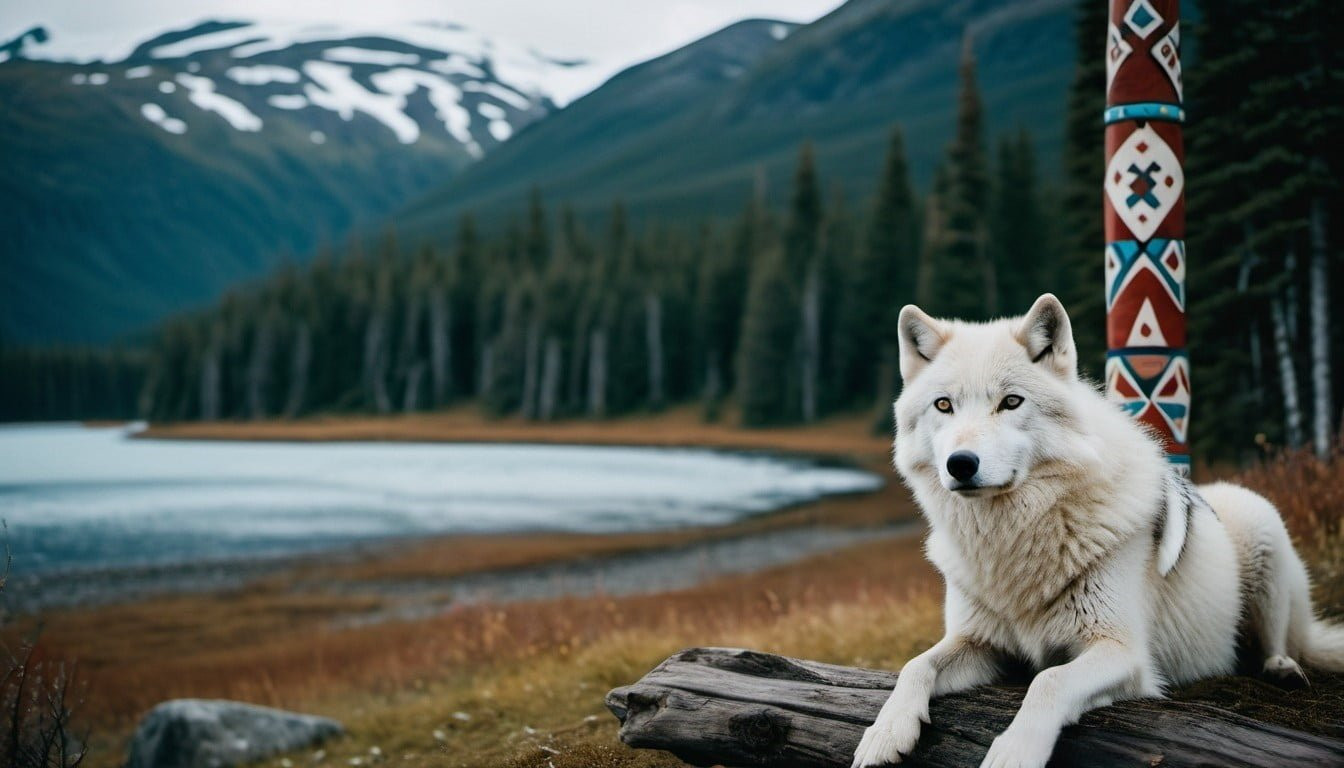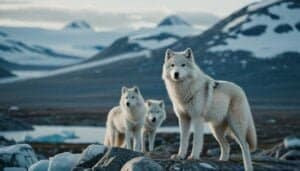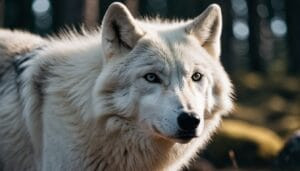Introduction
Arctic wolves hold a special place in native Alaskan folklore, where they are often seen as powerful and mystical creatures. These wolves are more than just animals; they are symbols deeply embedded in the culture and traditions of indigenous Alaskan tribes
This article explores the various aspects of Arctic wolves in native folklore, including their symbolism, the themes of stories featuring them, and the rituals and lessons associated with these majestic creatures
Through an in-depth look at these elements, we can gain a better understanding of the cultural significance of Arctic wolves in Alaskan indigenous heritage
The Significance of Arctic Wolves in Native Alaskan Folklore
Arctic wolves are deeply rooted in the cultural heritage of native Alaskan tribes
They are often seen as symbols of strength, endurance, and the interconnectedness of life. Their portrayal in folklore is complex, reflecting both the respect and the fear that these majestic creatures inspire
Symbolism and Meaning
In native Alaskan folklore, Arctic wolves are often seen as spiritual beings with deep symbolic meanings. They are frequently associated with:
Strength and Endurance: Arctic wolves are admired for their ability to survive and thrive in the harsh conditions of the Arctic. This resilience is mirrored in the stories where wolves symbolize the ability to overcome obstacles and endure hardship
Loyalty and Family: Wolves are known for their strong pack dynamics and family bonds. In folklore, they often represent loyalty, community, and the importance of family
Guidance and Wisdom: As creatures of the wild, wolves are sometimes seen as guides and protectors. They are believed to possess wisdom and knowledge of the land, leading people through difficult times and teaching them important life lessons
Positive and Negative Portrayals
The portrayal of Arctic wolves in native Alaskan folklore is nuanced, featuring both positive and negative aspects:
Positive Portrayals: Wolves are often depicted as noble creatures, embodying virtues such as bravery, loyalty, and wisdom. In many tales, they are protectors and allies to humans, offering guidance and support in times of need. Stories may depict wolves saving individuals from danger or leading them to safety
Negative Portrayals: Conversely, some stories portray wolves as cunning and dangerous predators. These tales highlight the fear and caution that people must have when dealing with the wild. Wolves may be depicted as tricksters or antagonists, challenging humans and testing their resolve
Cultural Significance and Uses
Arctic wolves hold significant cultural importance among native Alaskan tribes. Their presence in folklore is not just about the stories themselves but also about the broader cultural practices and beliefs that they inspire:
Art and Symbolism: Wolves are common motifs in native Alaskan art, including carvings, totems, and clothing. These representations often carry deep spiritual meanings and are used to convey cultural stories and values
Ceremonies and Rituals: Wolves play a role in various ceremonies and rituals. They may be invoked in hunting rituals, where their strength and hunting skills are admired and called upon for success. Some tribes have specific dances and songs dedicated to wolves, celebrating their importance in the ecosystem
Educational Tools: Folktales involving wolves are used as educational tools to teach younger generations about survival, respect for nature, and the importance of community. These stories are passed down orally, ensuring that the cultural heritage and wisdom are preserved
Common Themes and Stories Involving Arctic Wolves
Arctic wolves feature prominently in native Alaskan folklore, where they often embody various themes and play central roles in many stories
These tales reflect the values, beliefs, and observations of the indigenous peoples, providing insight into their relationship with the natural world
Common Themes in Arctic Wolf Tales
Several recurring themes can be identified in the stories involving Arctic wolves:
Survival and Adaptation: Many tales highlight the wolf’s ability to survive in the harsh Arctic environment. These stories often serve as metaphors for human resilience and the necessity of adapting to one’s surroundings
Leadership and Guidance: Wolves are frequently depicted as leaders or guides. Stories often involve wolves leading lost travelers to safety or guiding individuals through challenging situations, symbolizing wisdom and direction
Community and Cooperation: The social structure of wolf packs is a common theme, reflecting the importance of community, cooperation, and mutual support. These stories emphasize the values of teamwork and collective strength
Mysticism and Spirituality: Arctic wolves are sometimes portrayed as mystical creatures with spiritual significance. They may possess magical abilities or serve as messengers between the physical and spiritual worlds, highlighting the interconnectedness of all life
Specific Examples of Tales
Several specific tales illustrate the prominent role of Arctic wolves in native Alaskan folklore:
The Wolf Guide: A common story tells of a hunter who becomes lost in a blizzard. As he struggles to find his way, a white wolf appears and leads him back to his village. The wolf disappears as mysteriously as it arrived, leaving the hunter and his people to believe that it was a spirit sent to protect him
The Pack’s Revenge: In this tale, a group of hunters kills a wolf, not knowing that it was the leader of a pack. The pack then seeks revenge, systematically outsmarting and intimidating the hunters until they are forced to leave the wolves’ territory. This story underscores the themes of respect and retribution
The Wise Old Wolf: An elderly wolf, known for its wisdom, advises a young tribal leader on matters of great importance. The wolf’s counsel helps the leader make decisions that benefit the entire community, illustrating the value of listening to the wisdom of elders and the natural world
Interactions with Other Animals
In native Alaskan folklore, Arctic wolves often interact with other animals, creating a rich tapestry of relationships and dynamics:
Wolves and Ravens: One common motif involves wolves and ravens working together. The raven, known for its cunning, scouts for prey and alerts the wolves, who then share the spoils. This symbiotic relationship highlights the importance of cooperation and mutual benefit in the natural world
Wolves and Bears: Another frequent interaction is between wolves and bears, often depicted as rivals. These stories can involve conflicts over territory or resources, emphasizing the themes of competition and survival
Wolves and Caribou: The predator-prey relationship between wolves and caribou is also a significant theme. These stories often illustrate the balance of nature and the cycle of life, where each animal plays a crucial role in the ecosystem
Rituals, Traditions, and Lessons from Arctic Wolf Folklore
The depiction of Arctic wolves in native Alaskan folklore extends beyond storytelling. These majestic animals are integral to various rituals, traditions, and lessons that carry significant cultural and spiritual meanings
Rituals and Traditions
Arctic wolves feature prominently in numerous rituals and traditions among native Alaskan tribes, often symbolizing strength, endurance, and spiritual guidance:
Hunting Rituals: Before embarking on hunting expeditions, tribes would often invoke the spirit of the Arctic wolf
This practice involved chants, dances, and offerings meant to garner the wolf’s strength and hunting prowess, ensuring a successful and safe hunt. The wolf was seen as a master hunter whose skills could be imparted to the hunters through these rituals
Coming-of-Age Ceremonies: In some cultures, young individuals undergoing coming-of-age ceremonies might participate in rituals involving the Arctic wolf
These rites of passage would include wearing wolf pelts, learning wolf calls, and engaging in symbolic hunts, signifying the transition into adulthood and the acquisition of wisdom and strength akin to the wolf’s
Spiritual Ceremonies: Arctic wolves are considered spiritual guides in many native Alaskan beliefs
During spiritual ceremonies, shamans might wear wolf masks or invoke wolf spirits to seek guidance, protection, and insight. These ceremonies reinforce the belief in the interconnectedness of humans, animals, and the spirit world
Morals and Lessons
Stories involving Arctic wolves often carry profound moral lessons and teachings, imparted through generations to convey essential values and principles:
Respect for Nature: A common lesson from Arctic wolf tales is the importance of respecting nature and all its inhabitants
Stories emphasize that humans must live in harmony with the natural world, acknowledging the wolf’s role in maintaining ecological balance and understanding the consequences of disrupting this harmony
Courage and Perseverance: Many tales highlight the wolf’s bravery and determination, encouraging individuals to face their challenges with courage and perseverance. Wolves’ ability to endure harsh conditions and overcome obstacles serves as a metaphor for human resilience and tenacity
Community and Cooperation: The social structure and teamwork of wolf packs often serve as analogies for human communities
These stories teach the value of cooperation, mutual support, and the strength derived from working together towards common goals. They underscore the importance of familial bonds and collective effort in overcoming adversity
Wisdom and Guidance: Arctic wolves are frequently depicted as wise guides, leading lost or troubled individuals to safety
These tales impart the lesson that wisdom can be found in nature and that seeking guidance from the natural world can lead to enlightenment and salvation
Influence on Modern Perceptions
The rich tapestry of Arctic wolf folklore continues to influence modern perceptions of these animals, both within native Alaskan communities and beyond:
Conservation Efforts: The reverence for Arctic wolves in folklore has contributed to contemporary conservation efforts
Understanding the cultural significance of these animals helps garner support for protecting their natural habitats and ensuring their survival. Conservationists often draw upon traditional stories to promote awareness and respect for Arctic wolves
Cultural Revitalization: As native Alaskan communities work to preserve and revitalize their cultural heritage, the stories and traditions involving Arctic wolves play a crucial role
These narratives are integrated into educational programs, cultural festivals, and artistic expressions, reinforcing cultural identity and continuity
Art and Literature: Arctic wolves continue to inspire modern art and literature, reflecting their enduring symbolic power. Artists and writers draw on traditional folklore to create works that celebrate the wolf’s mystique and significance, bridging past and present cultural expressions
Conclusion
Arctic wolves hold a revered and multifaceted place in native Alaskan folklore, symbolizing strength, resilience, and spiritual guidance
Their portrayal in stories and traditions reflects a deep respect for these majestic creatures and the natural world they inhabit. From the symbolism and meaning attributed to wolves to their complex portrayals as both noble and cunning beings, Arctic wolves embody the values and lessons vital to native Alaskan cultures
Through common themes in stories, specific tales, and interactions with other animals, these narratives offer insights into the interconnectedness of life and the wisdom of the natural world
Rituals and traditions involving Arctic wolves highlight their cultural significance, underscoring the importance of community, cooperation, and spiritual guidance. The moral lessons conveyed through these stories teach respect for nature, courage, perseverance, and the value of wisdom
The influence of Arctic wolf folklore extends to modern perceptions, contributing to conservation efforts, cultural revitalization, and contemporary art and literature. By preserving and celebrating these rich narratives, native Alaskan communities maintain a vital connection to their heritage, ensuring that the legacy of the Arctic wolf continues to inspire and guide future generations
Arctic wolves, through their storied presence in folklore, remain powerful symbols of the natural world’s enduring beauty and wisdom, reminding us of the importance of living in harmony with nature and each other











